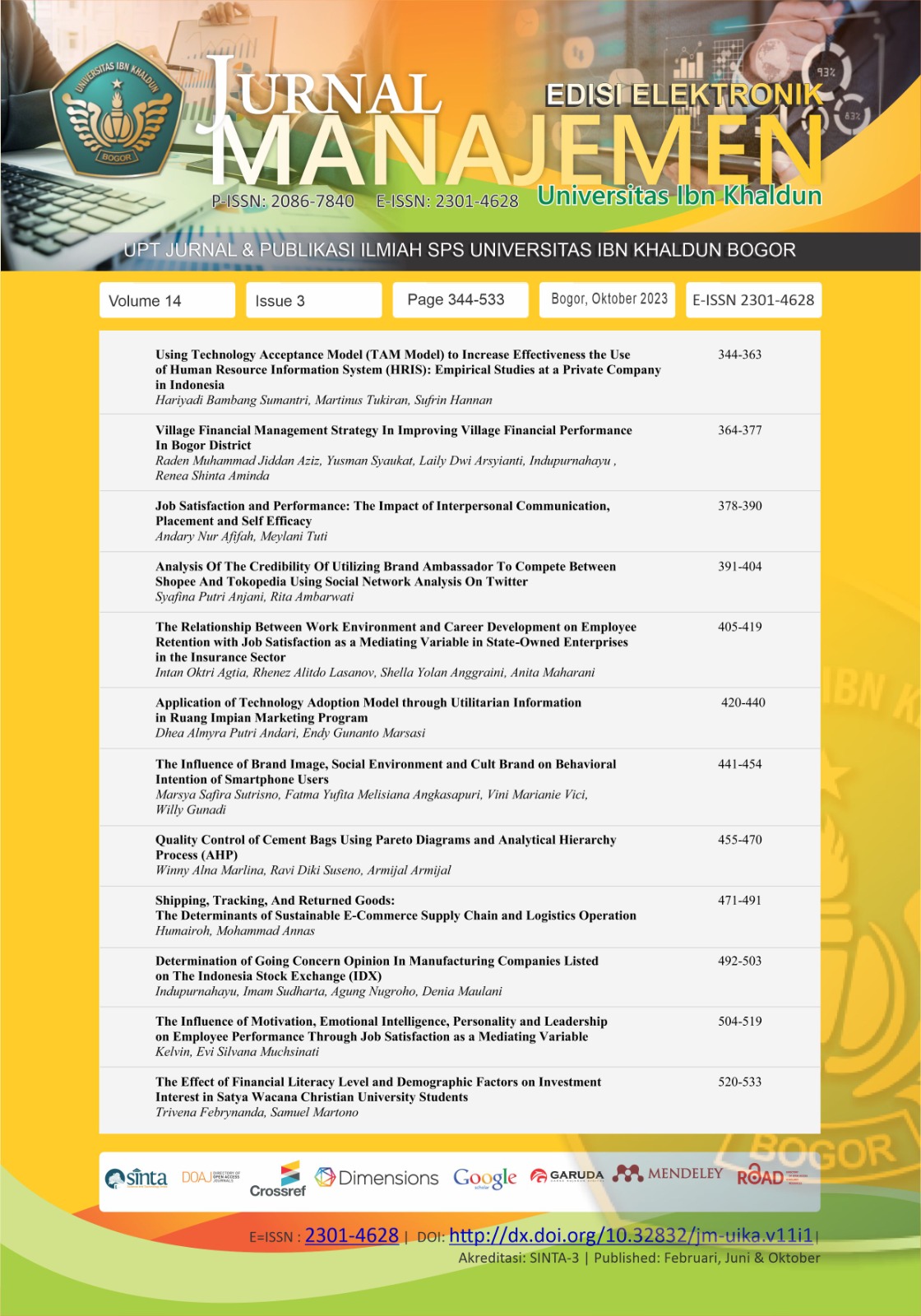Application of Technology Adoption Model through Utilitarian Information in Ruang Impian Marketing Program
DOI:
https://doi.org/10.32832/jm-uika.v14i3.14946Keywords:
Technology Adaption Model, Utilitarian Information , Marketing Management , Digital EconomyAbstract
Researchers examined a company engaged in interior design providing various facilities from artistry to furniture supplies. This study aims to propose a marketing program to evaluate the marketing carried out by companies through social media. This study used Observation, in-depth interviews, secondary company data, documentation, and descriptive qualitative research methodologies collection. This research resulted in an analysis of the proposal of the Ruang Impian program, a program to do marketing through social media. This program proposal is assisted by the theory of the Technology Acceptance Model with the concept of Utilitarian Information to help companies develop social media. It is hoped that the Technology Acceptance Model with the idea of Utilitarian Confirmation can help the company's marketing develop and become a force for DENTUUM.
References
Ajeng, N. J. D., &; Marsasi, E. G. (2023). IoT-Based Integrated Marketing Communica-tion in Closing Quality Agent Marketing Program. Journal of Business Economics Infor-matics, 5(1), 198-208. https://doi.org/10.37034/infeb.v5i1.229
Al-Qaysi, N., Mohamad-Nordin, N., &; Al-Emran, M. (2020). review, Employing the tech-nology acceptance model in social media: A systematic. Education and Information Tech-nologies. DOI:10.1007/S10639-020-10197-1
Alsyouf, A., Lutfi, A., Alsubahi, N., Alhazmi, F. N., Al-Mugheed, K., Anshasi, R. J., . . . Albugami, M. (2023). The Use of a Technology Acceptance Model (TAM) to Predict Pa-tients' Usage of a Personal Health Record System: The Role of Security, Privacy, and Usa-bility. Int. J. Environ. Res. Public Health, 20(2). DOI: https://doi.org/10.3390/ijerph20021347
Appel, G., Grewal, L., Hadi, R., &; Stephen, A. T. (2020). The future of social media in marketing. Journal of the Academy of Marketing Science, 79-95.
Azhar, M., Akhtar, M. J., Rahman, M. N., &; Khan, F. A. (2023). Measuring buying in-tention of Generation Z on social networking sites: an application of social commerce adoption model. Journal of Economic and Administrative Sciences. doi:https://doi.org/10.1108/JEAS-02-2022-0047
Barta, S., Gurrea, R., &; Flavián, C. (2023). Using augmented reality to reduce cognitive dissonance and increase purchase intention. Computers in Human Behavior, 140.
Bhatiti, A., &; Rehman, U. S. (2020). Perceived benefits and perceived risks affect primary online shopping behavior with the mediating role of consumer purchase inten-tion in Paki-stan. International Journal of Management Studies, 26 (1), 33–54.
Chandrruangphen, E., Assarut, N., &; Sinthupinyo, S. (2021). Shopping motivation in live streaming: A means-end chain approach. Proceedings of the 2nd International Con-ference on Research in Management.
Chatterjee, S., &; Kar., A. (2020). Why Do Small and Medium Enterprises Use Social Me-dia Marketing and What Is the Impact: Empirical Insights from India. International Journal of Information Management, 53, 1-13.
Creswell, J, W., & Creswell, J, D. (2018). Desain Penelitian: Pendekatan Kualitatif, Kuanti-tatif, dan Mix Methods Edisi ke-5. Los Angeles: Bijak.
Cuny, C., Pinelli, M., Fornerino, M., & deMarles, A. (2020). Experiential art infusion ef-fect on a service’s brand: the role of emotions. Journal of Marketing Management, 36(11-12), 1055-1075.
Cuong, D. T. (2020). The role of brand trust as a mediator in the relationship be-tween brand satisfaction and purchase intention. International Journal of Psychosocial Rehabilita-tion, 24. doi:10.37200/IJPR/V24I6/
Dwivedi, Y. K., Ismagilova, E., Hughes, D. L., Carlson, J., Filieri, R., Jacobson, J., . . . Jen-nifer. (2021). Setting the future of digital and social media marketing research: Per-spectives and research propositions. International Journal of Information Management, 59.
Gidaković, P., &; Zabkar, V. (n.d.). How Industry and Occupational Streotypes Sahpe Consumer's Trust, Value, and Loyalty Judgements Concerning service brands. Journal of Service Management, 32(6), 92-113. doi:10.1108/JOSM-12-2020-0447
Gupta, M., Sinha, N., Singh, P., &; Liébana-Cabanillas, F. (2021). Instagram Advertising among Young Consumers in Wearable Fitness Trackers: The Moderating Role of Tech-nology Acceptance Factors. Journal of Global Marketing, 1-22. DOI:10.1080/08911762.2021.1931616
Hossain, T. M., Akter, S., Kattiyapornpong, U., &; Dwivedi, Y. (2020). Reconceptualiz-ing integration quality dynamics for omnichannel marketing. Industrial Marketing Man-agement, 87, 225-241. DOI:https://doi.org/10.1016/j.indmarman.2019.12.006
İlter, A. T. (2021). Architects' Reactions to COVID-19 Pandemic with Evidence from Their Social Media Accounts. International Journal of Architecture and Planning, 10(1), 159-178. doi:10.15320/ICONARP.2022.198
Kamal, S. A., Shafiq, M., &; Kakria, P. (2020). investment acceptance of telemedicine ser-vices through an extended technology acceptance model (TAM). Technology in Soci-ety, 60.
Lal, B., Ismagilova, E., Dwivedi, Y. K., &; Kwayu, S. (2020). Return on Investment in So-cial Media Marketing: Literature Review and Suggestions for Future Research. Digital and Social Media Marketing. Advances in Theory and Practice of Emerging Markets. Springer, Cham, 3-17. DOI:https://doi.org/10.1007/978-3-030-24374-6_1
Liao, S.-H., Widowati, R., & Cheng, C.-J. (2022). Investigating Taiwan Instagram users' behaviors for social media and social commerce development. Entertainment Compu-ting, 40.
Marija Cimbaljević, D. D., Kovačić, S., Pavluković, V., Stankov, U., &; Vujičić, M. (2023). Employees' technology adoption in the context of smart tourism development: the role of technological acceptance and technological readiness. European Journal of Innovation Management. DOI: https://doi.org/10.1108/EJIM-09-2022-0516
Marikyan, D., &; Papagiannidis, S. (2021). Unified Theory of Acceptance and Use of Technology: A review. In S. Papagiannidis (ed). TheoryHub Book.
Marsasi, E. G., &; Barqiah, S. (2023). They The Role of Gender, Age, And Educational Groups in Utilitarian Motivation for Sharia Products. Indonesian Journal of Business and Entrepreneurship (IJBE), 9(1), 104-104.
Murat, K., &; Dilsad, G. (2022). An Investigation of The Effect of Social Media Market-ing and Innovation on Firm Performance with The Technology Acceptance Model. Sosy-oekonomi, 30(54), 145-163.
Onem, M., & Hasirci, D. (2020, December). Designing brand experience in interior space. In IOP Conference Series: Materials Science and Engineering (Vol. 960, No. 2, p. 022005). IOP Publishing.
Oyman, M., Bal, D., &; Ozer, S. (2022). Extending the technology acceptance model to ex-plain how perceived augmented reality affects consumers' perceptions. Computers in Hu-man Behavior, 128. DOI:https://doi.org/10.1016/j.chb.2021.107127
Park, E. (2020). . User acceptance of smart wearable devices: An expectation-confirmation model approach. Telematics and Informatics, 47.
Pongratte, L. J., Liu, J., Daughter, M. D., &; Paulin, A. (2023). The Effect of Promotion via TikTok Live Streaming on Consumers' Buying Interest in Clothing Products. Open Journal of Social Sciences, 11, 333-347.
Quartier, K., Claes, S., & Vanrie, J. (2020). A holistic competence framework for (fu-ture) retail design and retail design education. Journal of Retailing and Consumer Ser-vices, 55, 101914.
Rizaty, M. A. (2022, July 12). The Second Largest Indonesian Tiktok User in the World. Retrieved from https://dataindonesia.id/Digital/detail/pengguna-tiktok-indonesia-terbesar-kedua-di-dunia
Rodrigues, M., Franco, M., Sousa, N., Silva, R., &; Kyriakopoulos, L. (2021). Reviewing COVID-19 Literature on Business Management: What It Portends for Future Research? Sustainability. Sustainability, 13(11). DOI:https://doi.org/10.3390/su13115995
Song, M. C., & Liu, Y.-l. (2021). The effect of live-streaming shopping on the consum-er's perceived risk and purchase intention in China. 23rd Biennial Conference of the In-ternational Telecommunications Society (ITS): "Digital Societies and Industrial Trans-formations: Policies, Markets, and Technologies in a Post-Covid World", Online Confer-ence.
Sukendro, S. H., Khaeruddin, K., Indrayana, B., Syahruddin, S., Makadada, F. A., &; Ha-kim, H. (2020). Using an extended Technology Acceptance Model to understand stu-dents' use of e-learning during Covid-19: Indonesian sport science education context. Heliyon, 6(11).
Tajvidi, R., &; Karami, A. (2020). The Effect of Social Media on Firm Performance. Com-puters in Human Behavior, 115.
Tochaiwat, K., Nitierapad, C., Sawatdisara, P., & Pultawee, P. (2022). Determinants of the interior design of mock-up houses in housing projects with the use of modified ana-lytic hierarchy process. Int Trans J Eng Manag Appl Sci Technol, 13, 1-11.
Worthington, A. K., Burke, E. E., Shirazi, T. N., &; Leahy, C. (2020). US women's per-ceptions and acceptance of new reproductive health technologies. Women's Health Re-ports, 1(1), 402-412.
Zhang, S. X., Marioli, F. A., &; Gao, R. (2021). A Second Wave? What Do People Mean By COVID Waves? – A Working Definition of Epidemic Waves. MedRxiv. DOI:10.1101/2021.02.21.21252147
Downloads
Published
How to Cite
Issue
Section
License
Copyright (c) 2023 Jurnal Manajemen (Edisi Elektronik)

This work is licensed under a Creative Commons Attribution-NonCommercial 4.0 International License.
Authors who publish with this journal agree to the following terms:
- Authors retain copyright and grant the journal right of first publication with the work simultaneously licensed under a Creative Commons Attribution-NonCommercial-ShareAlike 4.0 International License that allows others to share the work with an acknowledgement of the work's authorship and initial publication in this journal.
- Authors can enter into separate, additional contractual arrangements for the non-exclusive distribution of the journal's published version of the work (e.g., post it to an institutional repository or publish it in a book), with an acknowledgement of its initial publication in this journal.
- Authors are permitted and encouraged to post their work online (e.g., in institutional repositories or on their website) prior to and during the submission process, as it can lead to productive exchanges, as well as earlier and greater citation of published work (See The Effect of Open Access).











